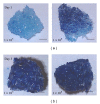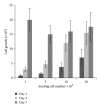The use of porous scaffold as a tumor model
- PMID: 24101930
- PMCID: PMC3786466
- DOI: 10.1155/2013/396056
The use of porous scaffold as a tumor model
Abstract
Background. Human cancer is a three-dimensional (3D) structure consisting of neighboring cells, extracellular matrix, and blood vessels. It is therefore critical to mimic the cancer cells and their surrounding environment during in vitro study. Our aim was to establish a 3D cancer model using a synthetic composite scaffold. Methods. High-density low-volume seeding was used to promote attachment of a non-small-cell lung cancer cell line (NCI-H460) to scaffolds. Growth patterns in 3D culture were compared with those of monolayers. Immunohistochemistry was conducted to compare the expression of Ki67, CD44, and carbonic anhydrase IX. Results. NCI-H460 readily attached to the scaffold without surface pretreatment at a rate of 35% from a load of 1.5 × 10(6) cells. Most cells grew vertically to form clumps along the surface of the scaffold, and cell morphology resembled tissue origin; 2D cultures exhibited characteristics of adherent epithelial cancer cell lines. Expression patterns of Ki67, CD44, and CA IX varied markedly between 3D and monolayer cultures. Conclusions. The behavior of cancer cells in our 3D model is similar to tumor growth in vivo. This model will provide the basis for future study using 3D cancer culture.
Figures







Similar articles
-
[Non-small cell lung cancer 95D cells co-cultured with 3D-bioprinted scaffold to construct a lung cancer model in vitro].Zhonghua Zhong Liu Za Zhi. 2015 Oct;37(10):736-40. Zhonghua Zhong Liu Za Zhi. 2015. PMID: 26813591 Chinese.
-
Polyurethane scaffold-based 3D lung cancer model recapitulates in vivo tumor biological behavior for nanoparticulate drug screening.Regen Biomater. 2023 Oct 25;10:rbad091. doi: 10.1093/rb/rbad091. eCollection 2023. Regen Biomater. 2023. PMID: 37965109 Free PMC article.
-
Three-dimensional constructs using hyaluronan cell carrier as a tool for the study of cancer stem cells.J Biomed Mater Res B Appl Biomater. 2015 Aug;103(6):1249-57. doi: 10.1002/jbm.b.33304. Epub 2014 Oct 28. J Biomed Mater Res B Appl Biomater. 2015. PMID: 25350680
-
3D printing novel in vitro cancer cell culture model systems for lung cancer stem cell study.Mater Sci Eng C Mater Biol Appl. 2021 Mar;122:111914. doi: 10.1016/j.msec.2021.111914. Epub 2021 Jan 29. Mater Sci Eng C Mater Biol Appl. 2021. PMID: 33641907
-
Enrichment of glioma stem cell-like cells on 3D porous scaffolds composed of different extracellular matrix.Biochem Biophys Res Commun. 2018 Apr 15;498(4):1052-1057. doi: 10.1016/j.bbrc.2018.03.114. Epub 2018 Mar 17. Biochem Biophys Res Commun. 2018. PMID: 29551682
Cited by
-
Three-Dimensional Spheroids as In Vitro Preclinical Models for Cancer Research.Pharmaceutics. 2020 Dec 6;12(12):1186. doi: 10.3390/pharmaceutics12121186. Pharmaceutics. 2020. PMID: 33291351 Free PMC article. Review.
-
Modeling multiple myeloma-bone marrow interactions and response to drugs in a 3D surrogate microenvironment.Haematologica. 2018 Apr;103(4):707-716. doi: 10.3324/haematol.2017.167486. Epub 2018 Jan 11. Haematologica. 2018. PMID: 29326121 Free PMC article.
-
Making In Vitro Tumor Models Whole Again.Adv Healthc Mater. 2023 Jun;12(14):e2202279. doi: 10.1002/adhm.202202279. Epub 2023 Feb 22. Adv Healthc Mater. 2023. PMID: 36718949 Free PMC article. Review.
-
3D tissue-engineered model of Ewing's sarcoma.Adv Drug Deliv Rev. 2014 Dec 15;79-80:155-71. doi: 10.1016/j.addr.2014.07.012. Epub 2014 Aug 7. Adv Drug Deliv Rev. 2014. PMID: 25109853 Free PMC article. Review.
-
Applications of Biomaterials in 3D Cell Culture and Contributions of 3D Cell Culture to Drug Development and Basic Biomedical Research.Int J Mol Sci. 2021 Mar 2;22(5):2491. doi: 10.3390/ijms22052491. Int J Mol Sci. 2021. PMID: 33801273 Free PMC article. Review.
References
-
- Hutmacher DW, Loessner D, Rizzi S, Kaplan DL, Mooney DJ, Clements JA. Can tissue engineering concepts advance tumor biology research? Trends in Biotechnology. 2010;28(3):125–133. - PubMed
-
- Zhang S. Beyond the Petri dish. Nature Biotechnology. 2004;22(2):151–152. - PubMed
-
- Yamada KM, Cukierman E. Modeling tissue morphogenesis and cancer in 3D. Cell. 2007;130(4):601–610. - PubMed
-
- Benton G, George J, Kleinman HK, Arnaoutova IP. Advancing science and technology via 3D culture on basement membrane matrix. Journal of Cellular Physiology. 2009;221(1):18–25. - PubMed
LinkOut - more resources
Full Text Sources
Other Literature Sources
Miscellaneous

